Euphorbia enopla, also known as Pincushion Euphorbia, is a unique-looking cactus native to South Africa. It’s relatively easy to care for, making it a popular choice in cultivation. The vibrantly colored spines make this succulent stand out in any garden setting.
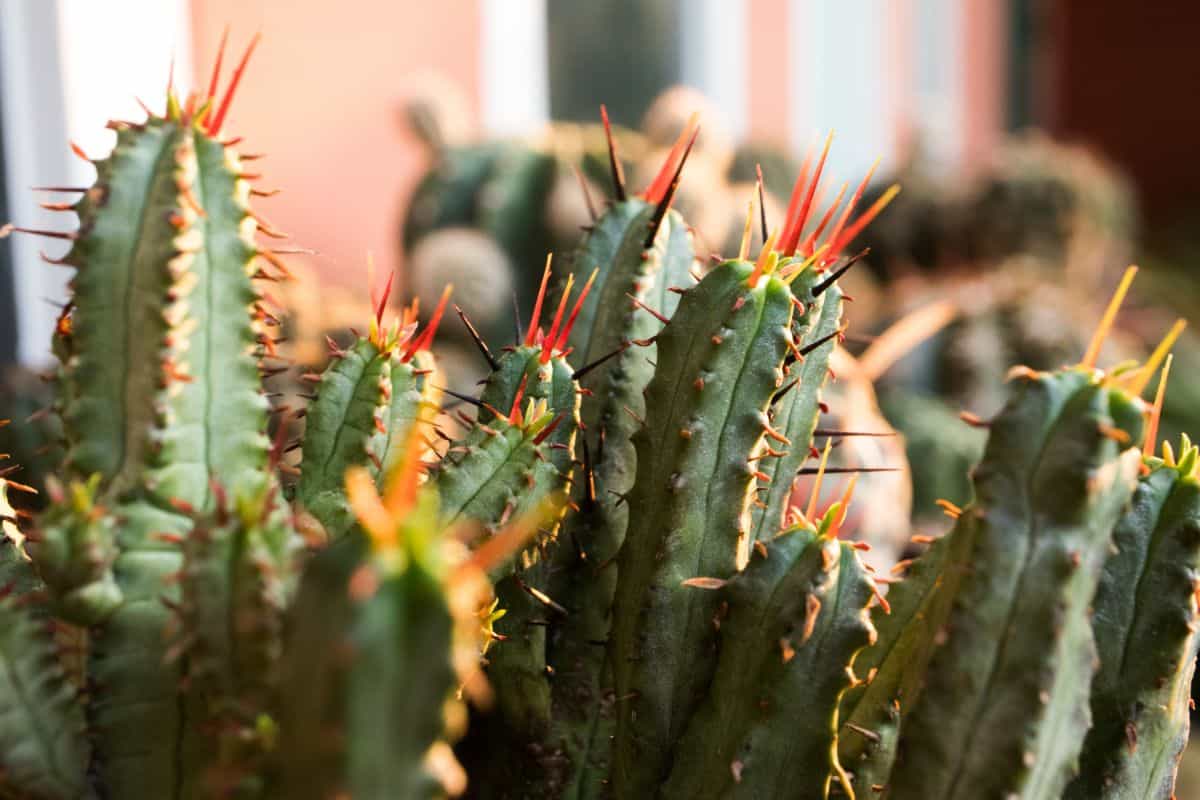
Though beautiful, these plants are toxic to pets and people, so caution should be taken in households with pets or children. Like other Euphorbia, the milky white sap of Pincushion Euphorbia can cause skin irritation, so they must be handled carefully.
Jump to:
Euphorbia enopla Appearance
| Name: | Euphorbia enopla |
| Soil: | Well-draining soil |
| Blooming: | Mid-late spring |
| Light: | Full sun |
| Water: | When the soil is dry |
| Propagation: | Stem cuttings, offsets, and seeds. |
Euphorbia enopla is sometimes confused with Euphorbia ferox because of their similar appearance, but the two species can be distinguished by the fatter stems of E. ferox. E. ferox also frequently has less vibrant color on its spines.
E.enopla is a shrubby succulent with numerous ribbed branches. The epidermis is typically dark green, greyish green, or bluish-green in color. The branches of this plant typically measure just over an inch in diameter. At maturity, Pincushion Euphorbia can reach up to three feet in height.
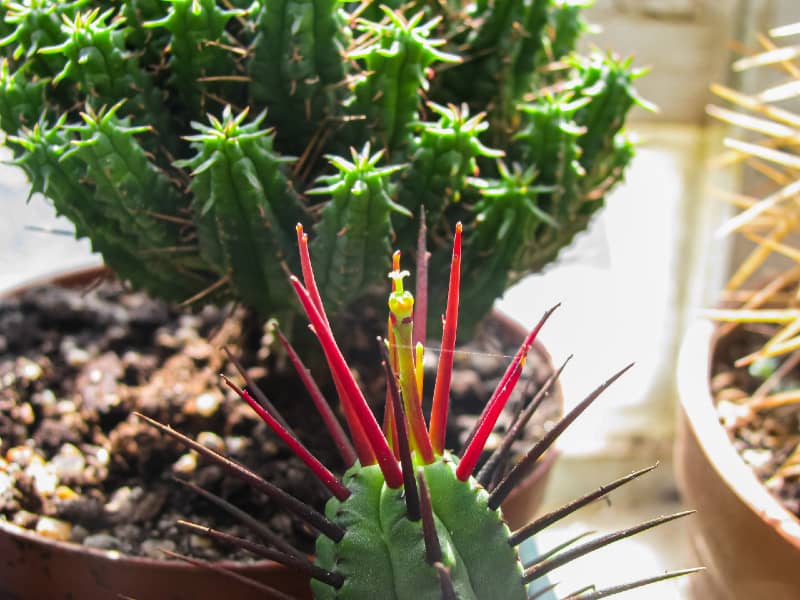
Buy it from:
The ribs of this succulent shrub are covered in thick, red spines just over a half-inch in length. As they age, the spines take on a purplish shade and eventually become gray.
The branches of Euphorbia enopla tend to grow in a vertical manner, resulting in an almost candelabra-like appearance. There are leaves, but they stay quite small and only remain attached for a brief time.
When in bloom, these plants produce either male or female flowers. Male flowers are a vibrant yellow in color, while female flowers are a deep shade of red. Male flowers are frequently much larger than the females.
Cultivars
The cristate form of this plant is called Euphorbia enopla cristata and can be distinguished from the original variety by the crested, fan-shaped branches. As with the original, the crested variety is also covered in bright red spines, though the spines are not as numerous.
Euphorbia enopla cristata tends to stay quite small, reaching only about four inches in diameter. Caring for the cristate form is as easy as growing the original variety as their care requirements are the same.
Caring for Euphorbia enopla
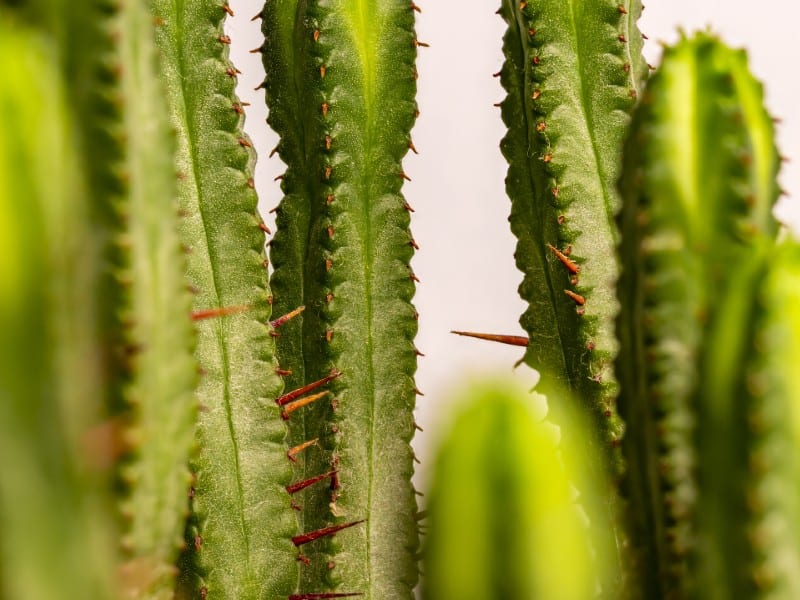
As previously mentioned, Euphorbia enopla is not a difficult plant to care for. In fact, more of these succulents tend to die from overwatering than neglect. Though they enjoy more water than other similar-looking species, care should be taken to ensure that these plants only receive as much water as they need and no more.
It should be noted that large specimens that don’t receive enough light grow more quickly than those grown in full sun, but they are not as strong. Their branches can become quite long and may not be strong enough to support themselves without additional support.
Water
Like other species of succulent, Euphorbia enopla prefers to be watered deeply but infrequently. It should be watered heavily enough for the excess to drain out the hole in the bottom of the pot but allow the soil to dry out before watering again.
In its native region, this cactus receives rainfall during both the summer and winter, so it can safely be watered year-round. However, if not kept in consistent conditions year-round, E. enopla will go dormant in winter. During dormancy, watering is not necessary.
Watering will need to be done more or less frequently depending on the weather, so it’s important to check the soil rather than relying on a set watering schedule. Otherwise, you may accidentally overwater the plant.
The soil can be checked by either inserting a soil moisture meter or your finger into the soil near the base of the plant. If the soil feels moist, or the meter reads moist, you need to wait a few days before checking again. Do not water until the soil is dry.
No products found.
If overwatered, Euphorbia are prone to developing root rot, which is usually a death sentence for the plant. Unfortunately, by the time signs of root rot are visible above the soil surface, it’s often too late to save the plant.
Light
Euphorbia enopla need quite a lot of light in order to keep their growth compact. Full sun is ideal, but in particularly hot climates, full sun may cause the plant’s color to bleach a bit.
When grown indoors, these plants do best in a bright window. A south-facing window is ideal, but a west or east-facing window may also work.
Without enough light, E. enopla can etiolate, or become stretched out. They will become untidy and leggy as they grow to seek out more light. Without adequate light, these plants do grow more quickly, but it’s not a healthy growth as they may reach lengths that cause the branches to break off.
If your indoor space doesn’t provide enough light for your Euphorbia to thrive, it’s recommended to invest in a grow light. Full-spectrum grow lights are typically quite inexpensive and easy to set up.
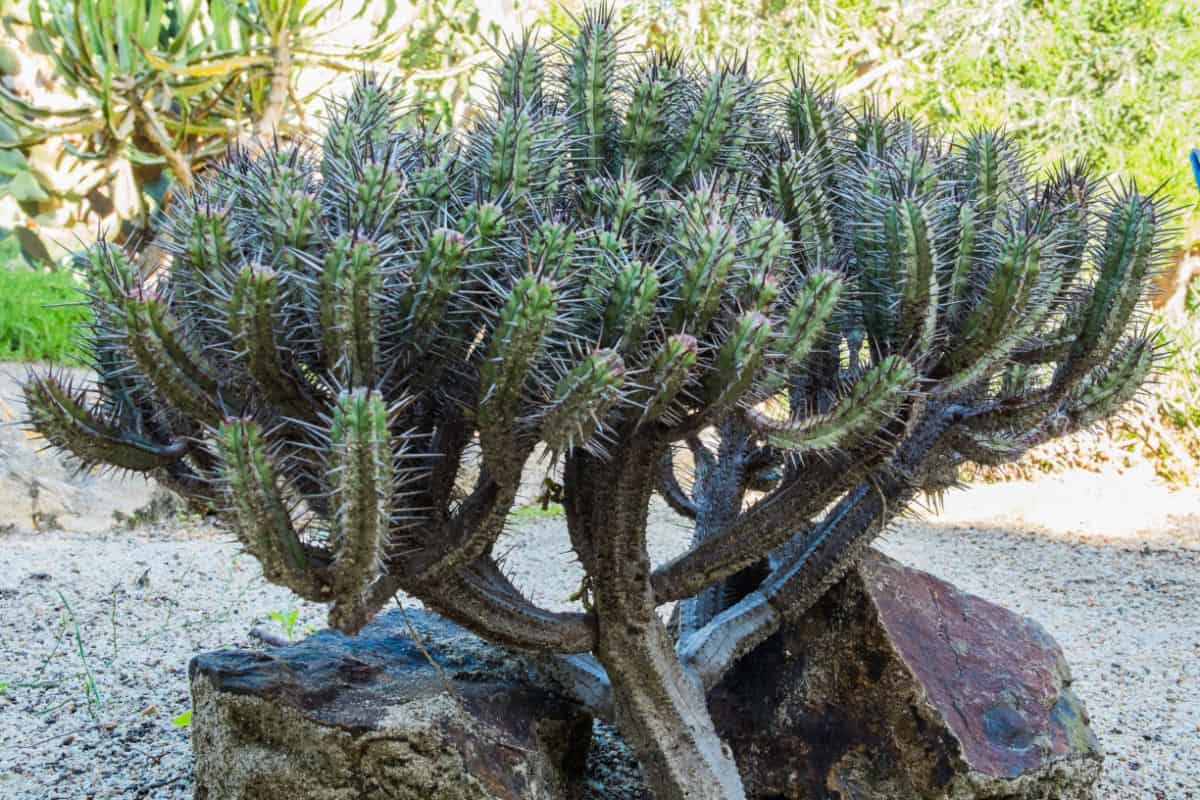
In the right climate, it’s also possible to grow Euphorbia enopla outdoors. Again, full sun is best, but partial shade may also work, especially in hot climates. In cooler climates, it can be taken indoors during the winter, so just make sure to plant it in an easily movable container rather than in the ground.
Read Related Topic: Euphorbia Lactea Cristata - A Care Guide
Temperature
Euphorbia enopla is capable of tolerating a light frost, but only when dry. This is not a plant that can grow outdoors in climates where winters are frigid. If you live in a climate where it typically stays above freezing during the winter, this plant can easily be grown outdoors.
In terms of heat, E. enopla is quite tolerant of high temperatures, especially when watered regularly. As mentioned earlier, the color may bleach some, but the plant will survive.
When kept indoors, temperatures are generally consistent enough not to worry about. However, it’s still best to keep your Euphorbia protected from sudden drafts or changes in temperature.
Soil
As with other species of succulent, Euphorbia enopla prefer well-draining soil with large particles to encourage airflow around the roots. A quick draining mineral-based substrate is essential in preventing accidental overwatering and root rot.
Avoid using soil mixes with large amounts of ingredients such as clay, coconut coir, and peat moss. These materials will encourage the retention of water and will not allow the soil to dry out as quickly as Euphorbia would like.
Instead, look for soil mixes with ingredients such as coarse sand, gravel, perlite, and even bark. Some organic material is fine so long as the majority of the mix is comprised of gritty mineral substrate.
If you’d prefer not to make your own soil mix, a commercial cactus or succulent soil will work fine. This type of mix allows for faster drainage than soils formulated for use with flowers and vegetables.
Though it’s not necessary, Euphorbia enopla does best when fertilized on occasion, especially when grown in pots. If your E. enopla has not yet outgrown its current container but you’re worried about the nutrients available in the soil, consider giving your plant a diluted dose of succulent approved plant food.
Most succulent gardeners recommend a 10-10-10 NPK formulated fertilizer for Euphorbia. Even if the label claims to be safe to apply without dilution, many gardeners dilute anyway just be sure that they don’t accidentally burn their plants.
Container
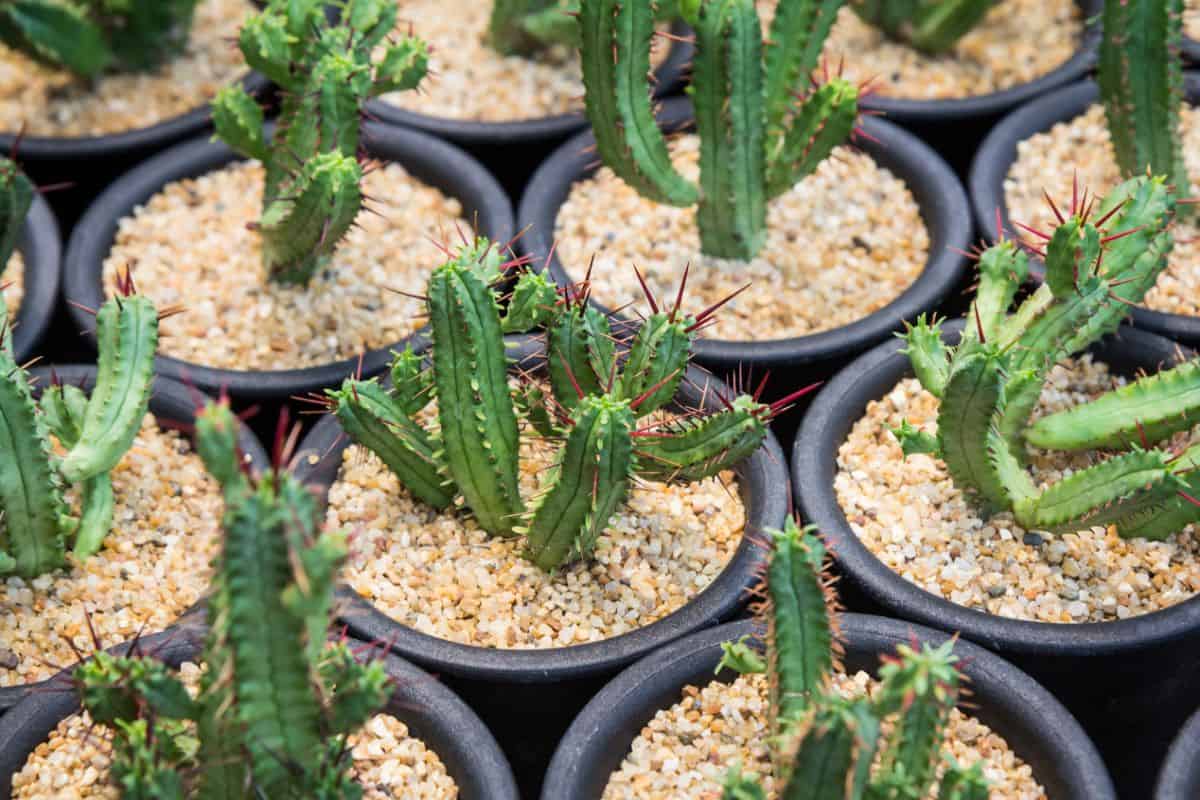
A properly draining container is essential in caring for Euphorbia enopla. Choosing a well-draining soil will do no good if the excess water is not able to drain out of the pot. As with any succulent, proper drainage is key in preventing root rot.
It is not recommended to plant Euphorbia in a container without a drainage hole as you must be incredibly precise in your watering schedule to prevent accidental overwatering. Since this plant likes the soil to dry out between watering, you’ll need to be certain that the container is dry all the way through before adding more water.
For this reason, most gardeners choose to grow their Euphorbia enopla, as well as any other succulent, in a container with a drainage hole. If you have the proper tools and skills, you can always drill a drainage hole if your pot doesn’t already have one.
As for the material of the pot, terra cotta is recommended if you have a tendency to overwater. Terra cotta has the ability to absorb some water out of the soil so it’s the most forgiving option.
Plastic or glazed ceramic pots cannot absorb water so you’ll need to consider this when deciding how often you need to water your plants.
Propagating Euphorbia enopla
There are three methods of propagating Euphorbia enopla. Each method has its pros and cons, but if you’re interested in experimenting, be sure to try something new. Growing Euphorbia from seeds can be particularly challenging, but it can be a fun and interesting project.
No matter which method you choose, it’s important to handle your Euphorbia carefully. Like other members of the Euphorbia family, E. enopla exudes a milky white sap when damaged. As previously mentioned, this sap can cause skin irritation, especially if exposed to the eyes or mouth.
It’s highly recommended to wear protective gear such as eye protection and gloves when handling Euphorbia. Not only will this help protect you from the spines, but the exuding sap as well.
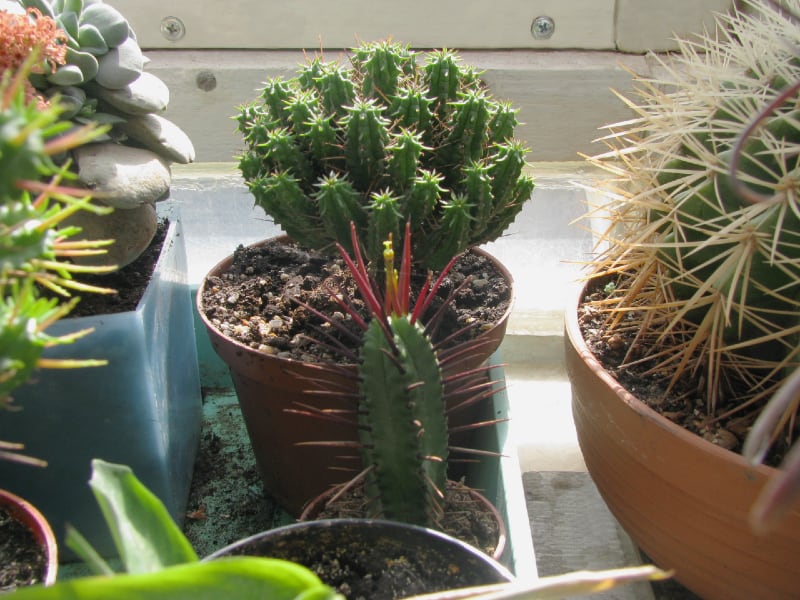
In addition to protective eyewear and gloves, you might also consider handling the cactus using a towel or several layers of newspaper. Use these materials as a protective layer between your gloved hands and the plant itself.
Euphorbia can be quite delicate, so it’s important to handle the plant gently. Gentle handling will prevent the spines from puncturing through the towel or newspaper. This will also limit your exposure to the sap.
As you collect your offsets or cuttings, you’ll also want to be careful if you have pets or children in the home. Keep them away from your gardening area while you’re working on your Euphorbia propagation project to prevent them from coming into contact with the toxic sap.
See Related Article: The Snowflake (Euphorbia polygona) Succulent Care Guide
Offsets
Removing the offsets produced by your Euphorbia enopla will be the easiest method of propagation. The mature plant will have done most of the work for you, all you need to do is separate the offset.
Offsets can be found around the base of the mature plant and are easily removed using your hands or protective layers of towels, newspaper, or even carpet.
If you’d like to make the job even easier, you can brush away some of the top layers of soil to expose the root system and gently divide the roots using a sharp, clean knife.
Once you have the offsets removed from the soil, you’ll need to lay them in a safe place out of direct sunlight to allow them to dry out for a few days. This drying period will allow the plant’s wounds to callous, which will prevent potential infection from fungus or bacteria.
After the wounds have calloused, you’re ready to plant your E. enopla offsets. Use the same careful handling techniques you used while collecting the offsets to plant them into well-draining soil in their own containers.
Once planted, you can begin caring for your new Euphorbia just as you would a mature specimen. Since they already have a root system, there’s little you need to do beyond basic care requirements.
Cuttings
Cuttings are also a popular method of Euphorbia enopla propagation. Though not quite as easy as offset removal, collecting and caring for cuttings is not a difficult process, even for inexperienced gardeners.
Collect cuttings from your Euphorbia using clean, sharp shears or scissors. Try to choose healthy-looking branches or stems. The exact size of your cuttings will depend on the size of your mature plant and how much you want to trim it back.
Again, be careful when handling to prevent injury from exuding sap or sharp spines. You’ll also need to be careful about the surface you place your cuttings on if your kids or pets may come into contact with it.
After collecting your cuttings, you’ll again need to give them a few days to air dry to let their wounds callous. After a few days in the open air, away from direct sunlight, your cuttings will be ready to plant.
At this point, you can either place your cuttings directly into a well-draining soil mix or dip them first in a rooting aid such as rooting hormone powder. Rooting aids are optional, but some gardeners find that they encourage faster rooting.
Once you’re ready to place your Euphorbia cuttings into the soil, you’ll need to make sure the soil stays a bit more moist than usual. This doesn’t mean standing water, of course, but slightly moister than you would normally keep it.
After a few weeks, you should begin to see tiny roots sprouting from the base of your cuttings. As the root system develops, you can begin treating your cuttings more like a mature Euphorbia.
Seeds
Growing Euphorbia enopla from seeds is not an easy task, but it can be an interesting challenge for any ambitious gardener. But first, you have to find the seeds.
Since this plant is a fairly prolific bloomer, you can collect seeds from your existing plants after blooming and pollination take place. This may seem a bit labor-intensive, but E. enopla seeds can be somewhat difficult to find, so if you already have the plant in your collection, you might try collecting seeds yourself.
If you’d prefer not to deal with the effort of collecting seeds from your existing Euphorbia, you’ll need to locate a reputable seed vendor. There are many great seed vendors to be found online, with more than a few specializing in rare or hard-to-find succulents such as this one.
Once you have the seeds in your possession, you’re ready to sow. You’ll want to place them in a fairly shallow container such as a seed tray. Deep containers can make it more difficult to control moisture levels and seedlings don’t need much depth anyway.
The soil you use should be the same fast-draining soil you would use with mature succulents. However, the difference between seeds and mature plants is that you need to keep the soil moist, but not overly wet.
Sow the seeds by sprinkling them across the surface of the soil. You can sprinkle a thin layer of soil over the top, but don’t bury them too deeply or they may not germinate.
Soil moisture can be retained by covering the container. Many types of seed trays have covers, but you can also use a sheet of glass or plastic wrap.
The seeds should be kept out of direct sunlight, but in a bright, warm place. You’ll want to maintain these conditions for a few weeks until you notice tiny Euphorbia seedlings sprouting at the surface of the soil.
Once the seedlings have appeared, you can begin to allow the soil to dry out a bit more. Even at this small size, rot is still a threat to be aware of, so avoid overly wet soil.
The seedlings will need to grow for some time until they’re sturdy enough to be transplanted to their own containers. However, once they’ve been moved to their own pots, they can be cared for as you would a mature E. enopla.


